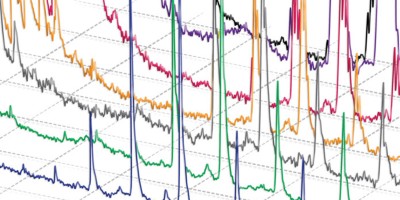Abstract
The progress of microwave-promoted reactions can be monitored by interfacing a Raman spectrometer with a scientific microwave unit. The apparatus is assembled from commercially available components. It is used in this protocol to follow the base-catalyzed reaction of salicylaldehyde with ethylacetoacetate to yield 3-acetylcoumarin. It is possible to watch the reaction spectroscopically in real time, determine when it reaches completion and thus use it as a tool for rapid reaction optimization.












Similar content being viewed by others
References
Loupy, A. (ed.) Microwaves in Organic Synthesis (Wiley-VCH, Weinheim, 2006).
Kappe, C.O. & Stadler, A. Microwaves in Organic and Medicinal Chemistry (Wiley-VCH, Weinhiem, 2005).
Lidström, P. & Tierney, J.P. (eds.) Microwave-assisted Organic Synthesis (Blackwell, Oxford, 2005).
Hayes, B.L. Microwave Synthesis: Chemistry at the Speed of Light (CEM Publishing, Matthews, NC, 2002).
Kappe, C.O. Controlled microwave heating in organic and medicinal chemistry. Angew. Chem. Int. Ed. Engl. 43, 6250–6284 (2004).
Larhed, M., Moberg, C. & Hallberg, A. Microwave-accelerated homogeneous catalysis in organic chemistry. Acc. Chem. Res. 35, 717–727 (2002).
Lew, A., Krutzik, P.O., Hart, M.E. & Chamberlain, A.R. Increasing rates of reaction: Microwave-assisted organic synthesis for combinatorial chemistry. J. Comb. Chem. 4, 95–105 (2002).
Tompsett, G.A., Conner, W.C. & Yngvesson, K.S. Microwave synthesis of nanoporous materials. ChemPhysChem 7, 296–319 (2006).
Robb, G.R., Harrison, A. & Whittaker, A.G. Temperature-resolved, in-situ powder X-ray diffraction of silver iodide under microwave irradiation. PhysChemComm 135–137 (2002).
Pivonka, D.E. & Empfield, J.R. Real-time in situ Raman analysis of microwave-assisted organic reactions. Appl. Spectrosc. 58, 41–46 (2004).
Barnard, T.M. & Leadbeater, N.E. Real-time monitoring of microwave-promoted organometallic ligand-substitution reactions using in-situ Raman spectroscopy. Chem. Commun. 3615–3616 (2006).
Leadbeater, N.E. & Smith, R.J. Real-time monitoring of microwave-promoted Suzuki coupling reactions using in situ Raman spectroscopy. Org. Lett. 8, 4588–4591 (2006).
Leadbeater, N.E., Smith, R.J. & Barnard, T.M. Using in situ Raman monitoring as a tool for rapid optimisation and scale-up of microwave-promoted organic synthesis: esterification as an example. Org. Biomol. Chem. 5, 822–825 (2007).
Leadbeater, N.E. & Smith R.J. In-situ Raman spectroscopy as a probe for the effect of power on microwave-promoted Suzuki coupling reactions. Org. Biomol. Chem. 5, 2770–2775 (2007).
Kulkarni, M.V. & Kulkarni, G.M. Lin C.H. & Sun, C.M. Recent advances in coumarins and 1-azacoumarins as versatile biodynamic agents. Curr. Med. Chem. 13, 2795–2818 (2006).
Jachak, S.M. & Saklani, A. Challenges and opportunities in drug discovery from plants. Curr. Sci. 92, 1251–1257 (2007).
Kostovam, I. Challenges and opportunities in drug discovery from plants. Curr. HIV Res. 4, 347–363 (2006).
Fylaktakidou, K.C., Hadjipavlou-Litina, D.J., Litinas, K.E. & Nicolaides, D.N. Natural and synthetic coumarin derivatives with anti-inflammatory/antioxidant activities. Curr. Pharm. Des. 10, 3813–3833 (2004).
Hepworth, J.D., Gabbut, C.D. & Heron, B.M. Pyrans and benzo derivatives: synthesis. In Comprehensive Heterocyclic Chemistry II Vol. 5 (eds. Katritzky, A.R., Rees, C.W., Scriven, E.F.V. & McKillop, A.) 1–55 (Pergamon, Oxford, 1996).
de la Hoz, A., Moreno, A. & Vazquez, E. Use of microwave irradiation and solid acid catalysts in an enhanced and environmentally friendly synthesis of coumarin derivatives. Synlett 608–610 (1999).
Frere, S., Thiery, V. & Besson, T. Microwave acceleration of the Pechmann reaction on graphite/montmorillonite K10: application to the preparation of 4-substituted 7-aminocoumarins. Tetrahedron Lett. 42, 2791–2794 (2001).
Rong, L.C., Li, X.Y., Shi, D.Q., Tu, S.J. & Zhuang, Q.Y. Efficient green procedure for the synthesis of coumarin derivatives by a one-pot, three-component reaction under Solvent Free conditions. Synth. Commun. 37, 183–189 (2007).
Rajitha, B., Kumar, V.N., Someshwar, P., Madhav, J.V., Reddy, P.N. & Reddy, Y.T. Dipyridine copper chloride catalyzed coumarin synthesis via Pechmann condensation under conventional heating and microwave irradiation. ARKIVOC 23–27 (2006).
Al-Zaydi, K.M. Microwave accelerated preparation of [bmim][HSO4] ionic liquid: an acid catalyst for improved synthesis of coumarins. Molecules 8, 541–555 (2003).
Bogdal, D. Coumarins: Fast synthesis by Knoevenagel condensation under microwave irradiation. J. Chem. Res. 468–469 (1998).
Acknowledgements
We thank the University of Connecticut for research funding. We acknowledge technical support from CEM Corporation (in particular T. Michael Barnard) and Enwave Optronics (in particular Eric Wu and Kevin Pan).
Author information
Authors and Affiliations
Corresponding author
Rights and permissions
About this article
Cite this article
Leadbeater, N., Schmink, J. Use of Raman spectroscopy as a tool for in situ monitoring of microwave-promoted reactions. Nat Protoc 3, 1–7 (2008). https://doi.org/10.1038/nprot.2007.453
Published:
Issue Date:
DOI: https://doi.org/10.1038/nprot.2007.453
- Springer Nature Limited
This article is cited by
-
Systematic functional analysis of Leishmania protein kinases identifies regulators of differentiation or survival
Nature Communications (2021)
-
Intranasal administration of resveratrol successfully prevents lung cancer in A/J mice
Scientific Reports (2018)
-
A single locus confers tolerance to continuous light and allows substantial yield increase in tomato
Nature Communications (2014)
-
Large accelerations from small thermal differences: case studies and conventional reproduction of microwave effects on palladium couplings
Reaction Kinetics, Mechanisms and Catalysis (2014)
-
Phenotyping soybean plants transformed with rd29A:AtDREB1A for drought tolerance in the greenhouse and field
Transgenic Research (2014)





